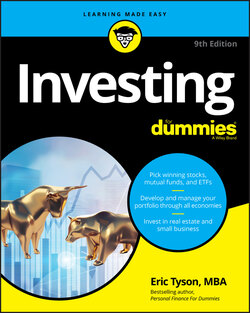Читать книгу Investing For Dummies - Eric Tyson - Страница 22
Steering Clear of Futures and Options
ОглавлениеSuppose you think that IBM’s stock is a good investment. The direction that the management team is taking impresses you, and you like the products and services that the company offers. Profits seem to be on a positive trend. Things are looking up.
You can go out and buy the stock. Suppose that it’s currently trading at around $100 per share. If the price rises to $150 in the next six months, you’ve made yourself a 50 percent profit ($150 – $100 = $50) on your original $100 investment. (Of course, you will incur some brokerage fees to buy and then sell the stock.)
But instead of buying the stock outright, you can buy what are known as call options on IBM. A call option gives you the right to buy shares of IBM under specified terms from the person who sells you the call option. You may be able to purchase a call option that allows you to exercise your right to buy IBM stock at, say, $120 per share in the next six months. For this privilege, you may pay $6 per share to the seller of that option (and you’ll also pay trading commissions).
If IBM’s stock price skyrockets to, say, $150 in the next few months, the value of your options that allow you to buy the stock at $120 will be worth a lot — at least $30. You can then simply sell your options, which you bought for $6 in the example, at a huge profit — you’ve multiplied your money five-fold!
Although this talk of fat profits sounds much more exciting than simply buying the stock directly and making far less money from a stock price increase, call options have two big problems:
You could easily lose your entire investment. If a company’s stock price goes nowhere or rises only a little during the six-month period when you hold the call option, the option expires as worthless, and you lose all — that is, 100 percent — of your investment. In fact, in my example, if IBM’s stock trades at $120 or less at the time the option expires, the option is worthless.
A call option represents a short-term gamble on a company’s stock price, not an investment in the company itself. In my example, IBM could expand its business and profits greatly in the years and decades ahead, but the value of the call option hinges on the ups and downs of IBM’s stock price over a relatively short period of time (the next six months). If the stock market happens to dip in the next six months, IBM may get pulled down as well, despite the company’s improving financial health.
Futures are similar to options in that both can be used as gambling instruments. Futures, for example, can deal with the value of commodities such as heating oil, corn, wheat, gold, silver, and pork bellies. Futures have a delivery date that’s in the not-too-distant future. (Do you really want bushels of wheat delivered to your home? Or worse yet, pork bellies?) You can place a small down payment — around 10 percent — toward the purchase of futures, thereby greatly leveraging your “investment.” If prices fall, you need to put up more money to keep from having your position sold. (Note: Futures on financial instruments like stock market indices and interest rates are generally cash settlement rather than physical delivery, and they’re an increasingly large part of the market.) My advice: Don’t gamble with futures and options.
The only real use that you may (if ever) have for these derivatives (so called because their value is “derived” from the price of other securities) is to hedge. Suppose you hold a lot of a stock that has greatly appreciated, and you don’t want to sell now because of the taxes you would owe on the profit. Perhaps you want to postpone selling the stock until next year because you plan on not working or because you can then benefit from a lower tax rate. You can buy what’s called a put option, which increases in value when a stock’s price falls (because the put option grants its seller the right to sell his stock to the purchaser of the put option at a preset stock price). Thus, if the stock price does fall, the rising put option value offsets some of your losses on the stock you still hold. Using put options allows you to postpone selling your stock without exposing yourself to the risk of a falling stock price.
